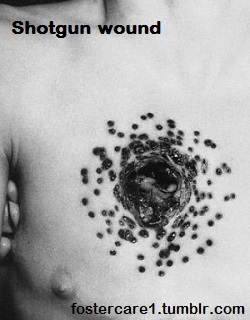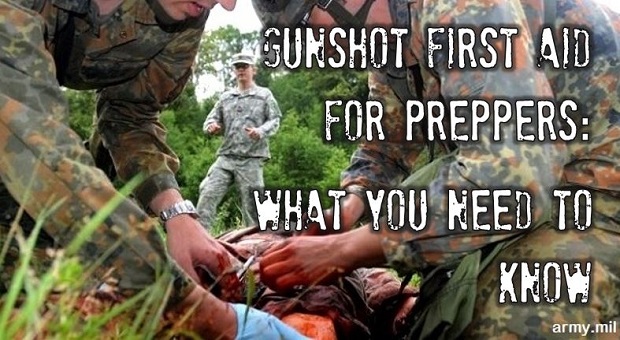In the greater preparedness schema, most preppers share common needs for generally similar equipment and resources. Firearms, and the protection and security they provide, are near the top of the list.
Almost every serious prepper is fairly well versed in acquiring suitable weapons and anything else regarding guns. They make it a point to practice and learn how to use them to defend yourself against the evil enemies.
But what many of us overlook and remain woefully absent of experience or knowledge is the flip side of the zombie coin. What if one of ‘them’ shoots one of your group, and you are now seriously wounded? How would you handle it?
What WOULD you do?
And more importantly what COULD you do?
You might be pretty good with CPR and regular ‘Bandaid first aid’, but what would you do in real time? What if you face the squirting, spurting, bloody mess of a gaping blackish red hole in someone’s shoulder from a blast of AK fire from intruders trying to breach your camp perimeter defense?
Well, pay seriously attention here, because this article might help you find some answers.
There’s never ANY true substitute for proper emergency care by well-trained first responders, or REAL medics or doctors.
But if you don’t have them in a bad SHTF scenario, a specific and easily learned knowledge and preparation for treatment of certain wounds dramatically increase at least the chance of the wounded person’s survival, when otherwise they would die in short time.
It’s pretty simple and fast once you have the right stuff in your survival med kit and familiarize yourself with the procedure described herein by watching videos of it how to use and do it. In some cases you can even patch yourself up like Rambo did if you are conscious, able, and determined to survive.
Standard ‘civilized’ wound trauma surgery is a highly refined and specific form of medical treatment. Today, even combat medics have a sophisticated procedure and support system designed to be highly coordinated and successful in some venues rivaling any hospital ER set up. There are usually specially trained field surgeons close enough to the battle zone with advanced field trauma centers and supplies where a high rate of survival is achieved.
But this is NOT what we are talking about here.
This is about your worst fear coming true as a prepper. Which is when your low profile ‘retreat and OPSEC’ mode is discovered and breached and you are now fighting in a life and death match with only two outcomes. You make it… or you don’t.
And for the sake of simplicity–which is actually the cold hard reality expectation when it all boils down to it–this info is based on the worse case doomsday scenario of having no hospital facilities, doctors, or trained field medics anywhere to help you. So only you or your ‘group’ will be able to do anything for yourselves.
What to Do? Stop the Bleeding, Treat for Shock, and Keep Them Breathing
ASAP after the wounded person goes down, quickly but carefully remove/cut away their clothing around the wound to clearly locate and assess the damage to allow room for wound dressing.
With bullet wounds, people initially usually die from bleeding out if a major critical organ is not hit to cause imminent death. Bleeding out enough to lose critical blood pressure will result in not enough irrigation to the brain which automatically causes ‘Shock’ which then begins to shut the body functions down, ultimately causing death.
To prevent this it is imperative to STOP any and ALL bleeding FAST. For multiple wounds you may have to remove most of the clothing and if the weather is freezing, this can be a problem unless you can quickly get the wounded inside or have warm blankets handy.
Be careful handling the wounded person because bullets also break bones on their way in and out that often can’t be seen. Movement can cause excruciating pain.
Bullet wounds are unique in that unlike a blunt trauma injury with a bat/pipe, knife, or even an arrow, the exit wound can be quite asymmetrical in its path through the body, sometimes amazingly so.
In the recent tragedy of the two uniform officers ambushed in the ongoing Ferguson, MO debacle one was struck in the shoulder and the exit wound was down in the lower back area! The second officer was hit in the face at the cheekbone and the bullet deflected to lodge behind the ear! First off this indicates to me that the rounds used were likely lower velocity .22 LR caliber which are notorious for that type of wound channeling.
With this officer it looks like they said that the doctors decided to leave the lodged bullet behind the ear alone for now. This is done for a reason. It’s bad enough in terms of surgical stress to the patient to fix the damage on the face so if they don’t have to immediately add to it, it’s sometimes better to wait until the first surgery heals.
Which brings up another important point…
…DON’T even think about replicating what you see in the old cowboy movies by digging around in the wound with your Blacksmith ‘horse shoe tongs’, or Bowie knife, to extract the bullet to proudly immortalize your surgical success!
Most high powered rounds will be through and through anyway exemplified by a larger ‘exit’ wound, and if not, as in the case of some rapidly expanding pistol hollow points which would be floating too deep for you to even know where it is anyway without an X-ray scan.
Without the proper surgical back up resources, you’re better off just stopping the bleeding and leaving well enough alone. Many have survived relatively unbothered by bullets and small pieces of shrapnel metal lodged in their bodies for years.
How to Prepare to Treat for Shock
While you are initially situating the victim and getting ready to ‘operate’, you might as well position the body to treat for shock with the legs elevated slightly.
Medical ‘Shock’–not to be confused with emotional/psychological PTSD type shock– is the term used to describe a complicated condition where many types/combination of trauma or pathological conditions causes not enough oxygenated blood irrigation due to low blood pressure to sustain critical organ function.
When blood pressure is lost from wound bleeding, as opposed to snake bite, heart weakness, toxic exposure, etc. it is known as hypovolemic shock, but the symptoms are all about the same.
If the patient was still conscious after being wounded and they also begin to go into shock they experience dizziness, breathing irregularity, rapid pulse, pale skin color, etc.
Left untreated, medical shock often leads to death. So if the wounded person is losing or already lost sufficient blood, the blood pressure must be restored after the bleeding is stopped by lifting the legs if that’s possible, or inclining the entire body so that blood flows to the heart and brain can be adequately irrigated.
There are additional causes and treatments for shock and it behooves any serious prepper to learn as much about it as possible. This is why you always see the IV bottle drip with at least a saline solution/plasma if they can’t type match a blood transfusion. They must keep a blood pressure/circulation and vitals function in stabilization to eventually create homeostasis and recovery,
Also be prepared to immediately perform CPR if there is a suspicious loss of consciousness.
Stopping Bleeding With Pressure Bandages Directly to All Wounds
 This is where it gets a bit complicated, especially if you don’t have the right bandages.
This is where it gets a bit complicated, especially if you don’t have the right bandages.
But nothing you can’t handle with some clear thinking and basic training.
There are ways to ‘improvise’ if nothing else. But if you are not dedicated enough to your survival prep plans to have a decent medical kit right along with your grab gun, your water filter, and your whiskey flask, then don’t get into gunfights anyway and you should just dig a deep hole somewhere–which will also serve as your grave–and hope nobody finds you.
There might be a large exit wound–the typical exit wounds of an AK or .223 round through the body can remain as large as golf ball after the tissue mass has constricted. If bone fragments are tearing through as well, then it will be larger.
That’s a nasty hole and if the heart is still pumping it will look like a park water fountain –only BLOOD red–and if really squirting or flowing that usually indicates veins and/or an artery was hit or ruptured also.
Treat that first by inserting a Celox or Quick Clot pack, an antibiotic powder or gel application and then a proper size compression bandage. Then go to the smaller entrance hole.
Otherwise if you don’t have a pressure bandage you have to press down and hold your bandage with sufficient power to preclude leakage until the Quick Clot does its thing by rapidly coagulating the wound area through a chemical process. Just a gauze pad and tape won’t be enough on a bullet wound. Pressure bandages like the Israeli bandage, have built in pressure torque clamping system and work well.
A ‘pressure bandage’ is just what it sounds like. It must be applied and kept under pressure. And we don’t just do a little pressing/holding it on while you tape it.
A victim can bleed out through a bandage a little slower but critically and not be noticed because the bandage absorbs and hides the flow the blood. The bleeding must be stopped at the wound. The bandage must be tightly pressed on the wound or the bleeding won’t be stopped properly.
Many are aware of the use of a tourniquet to stop large bleeding in the extremities. If you use the Quick Clot material and pressure bandages quickly and efficiently and the wound is not bleeding so profusely then you shouldn’t need a tourniquet.
But if a major artery is open and that you can’t even insert the Quick Clot material due to being unable to temporarily ‘sponge’ out the blood, then apply a tourniquet only as long as it takes you to dress the wound and stop the bleeding then remove it immediately afterward.
Once the bleeding has been stopped, make the victim comfortable and quiet while monitoring for shock and respiratory difficulties until further advanced treatment requirements can be ascertained and provided if possible.
Conclusion
The naked truth is that it’s a good/bad bet that anytime you become unfortunate enough to be involved in a gunfight, the odds of you getting wounded or killed, are just as ‘even’ as the other guys.
If that bothers you, and it should, make sure you implement an appropriate survival plan for it by getting some more detailed books or videos on the subject of survival medicine, practicing, and hopefully have someone in your family or ‘group’ get professionally trained in this type of medic work. You should also upgrade your basic ‘first aid’ kit with some of the proper medical supplies, safety strategies, and equipment.
A different piece of non-medical equipment but directly related and influential to the types of bullet wounds you might get is some good Body Armor, if you can afford it.
This would help mitigate the more serious bullet strikes to vital areas of the torso.
This article has been written by Mahatma Muhjesbude for Survivopedia.
[Total: 1 Average: 5/5]
42 total views, 42 views today
Source:: Survivopedia




